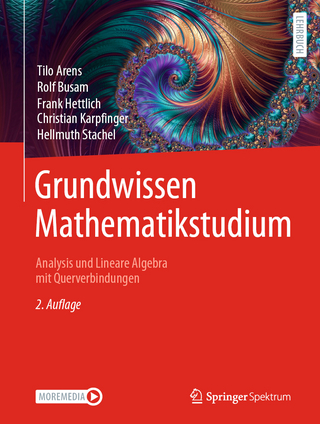
Thinking Mathematically
Pearson (Verlag)
978-0-321-69235-1 (ISBN)
- Titel erscheint in neuer Auflage
- Artikel merken
Bob Blitzer is a native of Manhattan and received a Bachelor of Arts degree with dual majors in mathematics and psychology (minor: English literature) from the City College of New York. His unusual combination of academic interests led him toward a Master of Arts in mathematics from the University of Miami and a doctorate in behavioral sciences from Nova University. Bob’s love for teaching mathematics was nourished for nearly 30 years at Miami Dade College, where he received numerous teaching awards, including Innovator of the Year from the League for Innovations in the Community College and an endowed chair based on excellence in the classroom. In addition to Thinking Mathematically, Bob has written textbooks covering introductory algebra, college algebra, algebra and trigonometry, and precalculus, all published by Prentice Hall. When not secluded in his Northern California writer’s cabin, Bob can be found hiking the beaches and trails of Point Reyes National Seashore, and tending to the chores required by his beloved entourage of horses, chickens, and irritable roosters.
1. Problem Solving and Critical Thinking
1.1 Inductive and Deductive Reasoning
1.2 Estimation, Graphs, and Mathematical Models
1.3 Problem Solving
2. Set Theory
2.1 Basic Set Concepts
2.2 Subsets
2.3 Venn Diagrams and Set Operations
2.4 Set Operations and Venn Diagrams with Three Sets
2.5 Survey Problems
3. Logic
3.1 Statements, Negations, and Quantified Statements
3.2 Compound Statements and Connectives
3.3 Truth Tables for Negations, Conjunction, and Disjunction
3.4 Truth Tables for the Conditional and the Biconditional
3.5 Equivalent Statements and Variations of Conditional Statements
3.6 Negations of Conditional Statements and De Morgan's Laws
3.7 Arguments and Truth Tables
3.8 Arguments and Euler Diagrams
4. Number Representation and Calculation
4.1 Our Hindu-Arabic System and Early Positional Systems
4.2 Number Bases in Positional Systems
4.3 Computation in Positional Systems
4.4 Looking Back at Early Numeration Systems
5. Number Theory and the Real Number System
5.1 Number Theory, Prime and Composite Numbers
5.2 The Integers; Order of Operations
5.3 The Rational Numbers
5.4 The Irrational Numbers
5.5 Real Numbers and Their Properties
5.6 Exponents and Scientific Notation
5.7 Arithmetic and Geometric Sequences
6. Algebra: Equations and Inequalities
6.1 Algebraic Expressions and Formulas
6.2 Linear Equations in One Variable and Proportions
6.3 Applications of Linear Equations
6.4 Linear Inequalities in One Variable
6.5 Quadratic Equations
7. Algebra: Graphs, Functions, and Linear Systems
7.1 Graphing and Functions
7.2 Linear Functions and Their Graphs
7.3 Systems of Linear Equations in Two Variables
7.4 Linear Inequalities in Two Variables
7.5 Linear Programming
7.6 Modeling Data: Exponential, Logarithmic, and Quadratic Functions
8. Consumer Mathematics and Financial Management
8.1 Percent, Sales Tax, and Income Tax
8.2 Simple Interest
8.3 Compound Interest
8.4 Annuities, Stocks, and Bonds
8.5 Installment Loans, Amortization, and Credit Cards
9. Measurement
9.1 Measuring Length; The Metric System
9.2 Measuring Area and Volume
9.3 Measuring Weight and Temperature
10. Geometry
10.1 Points, Lines, Planes, and Angles
10.2 Triangles
10.3 Polygons, Perimeter, and Tessellations
10.4 Area and Circumference
10.5 Volume
10.6 Right Triangle Trigonometry
10.7 Beyond Euclidean Geometry
11. Counting Methods and Probability Theory
11.1 The Fundamental Counting Principle
11.2 Permutations
11.3 Combinations
11.4 Fundamentals of Probability
11.5 Probability with the Fundamental Counting principle, Permutations, and Combinations
11.6 Events Involving Not and Or; Odds
11.7 Events Involving And; Conditional Probability
11.8 Expected Value
12. Statistics
12.1 Sampling, Frequency Distributions, and Graphs
12.2 Measures of Central Tendency
12.3 Measures of Dispersion
12.4 The Normal Distribution
12.5 Problem Solving with the Normal Distribution
12.6 Scatter Plots, Correlation, and Regression Lines
13. Mathematical Systems
13.1 Mathematical Systems
13.2 Rotational Symmetry, Groups, and Clock Arithmetic
14. Voting and Apportionment
14.1 Voting Methods
14.2 Flaws of Voting Methods
14.3 Apportionment Methods
14.4 Flaws of Apportionment Methods
15. Graph Theory
15.5 Graphs, Paths, and Circuits
15.2 Euler Paths and Euler Circuits
15.3 Hamilton Paths and Hamilton Circuits
15.4 Trees
| Erscheint lt. Verlag | 11.2.2010 |
|---|---|
| Sprache | englisch |
| Maße | 216 x 276 mm |
| Gewicht | 1910 g |
| Themenwelt | Mathematik / Informatik ► Mathematik |
| ISBN-10 | 0-321-69235-7 / 0321692357 |
| ISBN-13 | 978-0-321-69235-1 / 9780321692351 |
| Zustand | Neuware |
| Informationen gemäß Produktsicherheitsverordnung (GPSR) | |
| Haben Sie eine Frage zum Produkt? |
aus dem Bereich



